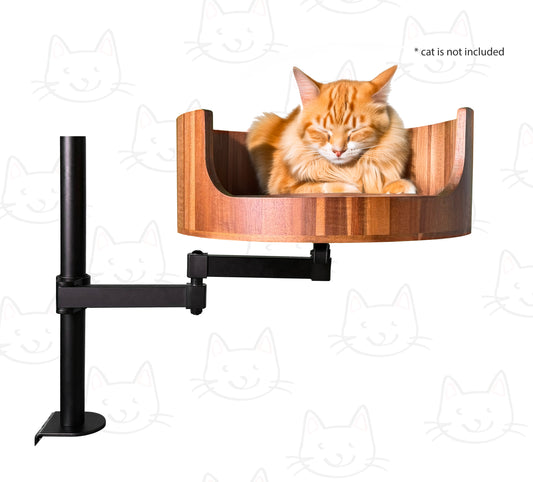
What Does It Mean When a Cat Wags Its Tail?
Share
Cat behavior can sometimes be puzzling to their human companions, especially when it comes to their tails. While dogs wag their tails as a sign of happiness or excitement, the meaning behind a cat's tail wagging can be more nuanced. Understanding what a cat's tail movements signify can help decode their emotions and improve communication between feline and human. In this article, we will explore the various reasons why cats wag their tails and what each movement may indicate.
One common misconception is that a cat wagging its tail is always a sign of agitation or anger. While this can be true in some cases, there are actually several different tail movements that can have multiple meanings. For example, a slow, deliberate wag of the tail may indicate that the cat is feeling curious or unsure, while a quick, aggressive wag could signal aggression or frustration. By paying attention to the speed, direction, and position of a cat's tail, pet owners can better interpret their feline companion's mood and respond accordingly. Stay tuned as we delve deeper into the fascinating world of cat communication through tail movements.
1. Cats wag their tails as a form of communication, with different tail movements indicating various emotions and intentions.
2. A slowly wagging tail can signify curiosity or uncertainty, while a rapidly flicking tail may indicate agitation or aggression.
3. It's important to consider the context in which a cat is wagging its tail to accurately interpret their feelings.
4. Tail wagging should be viewed in conjunction with other body language cues to better understand a cat's mood.
5. Understanding the meaning behind a cat's tail wagging can help owners better respond to their cat's needs and emotions.
Understanding Cat Tail Wagging
When a cat wags its tail, it can indicate various emotions or messages. While many people associate tail wagging with dogs, cats also use this behavior to communicate. Depending on the speed, angle, and position of the tail, a cat's wagging can signal feelings such as aggression, fear, excitement, or curiosity. It is essential to pay attention to other body language cues and the context in which the tail wagging occurs to interpret its meaning accurately.
Aggression and Fear
A cat wagging its tail quickly and forcefully can be a sign of aggression or fear. This behavior often accompanies puffed-up fur, narrowed eyes, and flattened ears, indicating that the cat feels threatened or defensive. In this case, it is crucial to give the cat space and avoid provoking it further to prevent a potential attack or escalation of the situation.
Excitement and Playfulness
On the other hand, a cat wagging its tail in a playful manner usually signifies excitement or anticipation. Cats may wag their tails gently while engaging in interactive play with toys or other pets. This type of tail wagging is typically accompanied by relaxed body language, dilated pupils, and vocalizations like purring or chirping. Understanding the context of the behavior can help differentiate between playful tail wagging and aggressive signals.
Curiosity and Communication
Sometimes, a cat may wag its tail as a sign of curiosity or to communicate with its owner or other animals. Tail wagging in this context is often slower and more deliberate, indicating interest or a desire for interaction. Cats may use their tails to express friendliness, submission, or a request for attention. By observing the cat's overall demeanor and responses to stimuli, pet owners can better understand the motivations behind their feline companion's tail wagging behavior.
Desk Cat Nest FAQ
What does it mean when a cat wags its tail?
When a cat wags its tail, it can indicate a range of emotions. It's important to consider the context and other body language signals the cat is displaying. In some cases, a tail wag may signal excitement or playfulness, while in other instances it could indicate irritation or aggression.
Should I be concerned if my cat wags its tail?
If your cat wags its tail in a slow, deliberate manner along with other signs of aggression such as flattened ears or dilated pupils, it's best to give the cat some space to calm down. It's important to monitor your cat's behavior and seek guidance from a veterinarian or animal behaviorist if you have concerns about your cat's aggression.
Can a cat wag its tail when it's happy?
Yes, a cat can wag its tail when it's happy or content. A gentle, relaxed wagging of the tail while the cat is purring or kneading can indicate a positive emotional state. Observing your cat's overall body language and behavior can help you determine whether the tail wag is a sign of happiness or another emotion.
In conclusion, understanding why a cat wags its tail is crucial for interpreting their behavior and mood. The Desk Cat Bed provides a comfortable and safe space for your feline friend to relax, reducing stress and anxiety that may trigger tail wagging. With its durable, quality construction and cozy design, this bed is a valuable choice for cat owners looking to provide their pets with a happy and calming environment. Invest in a Desk Cat Bed today to keep your cat content and tail wagging in joy.



















































